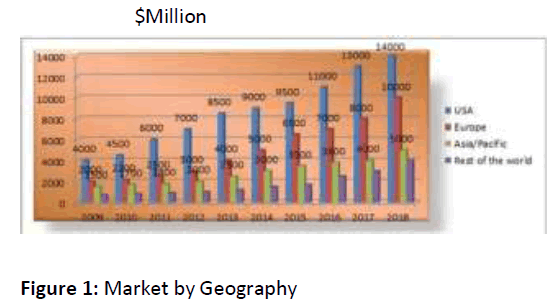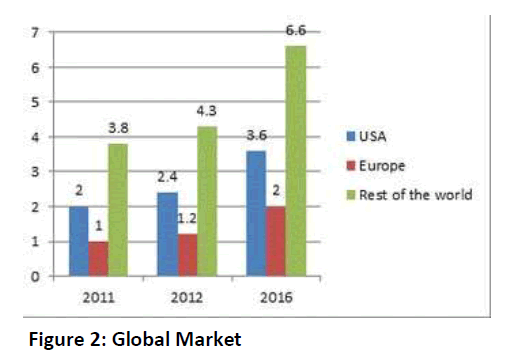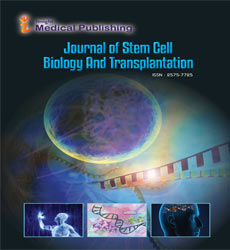ISSN : 2575-7725
Journal of Stem Cell Biology and Transplantation
Market Analysis- 12th World Congress and Expo on Stem Cell Research
University of Buenos Aires, Argentina Email: Claudiodufour@yahoo.com.ar
The success of the 11th Cell Science conferences series LLC Ltd has given us the prospect to bring the gathering one more time for our 12th World Congress 2020 meet in Prague Czech Republic, UK. Since its commencement in 2011 cell science series has perceived around 750 researchers of great potentials and outstanding research presentations around the globe. The awareness of stem cells and its application is increasing among the general population that also in parallel offers hope and add woes to the researchers of cell science due to the potential limitations experienced in the real-time.
Stem Cell Research-2020 has the goal to fill the prevailing gaps in the transformation of this science of hope to promptly serve solutions to all in the need. World Congress 2020 will have an anticipated participation of 100-120 delegates from around the world to discuss the conference goal.
History of Stem cells Research
Stem cells have an interesting history, in the mid-1800s it was revealed that cells were basically the building blocks of life and that some cells had the ability to produce other cells. Efforts were made to fertilize mammalian eggs outside of the human body and in the early 1900s, it was discovered that some cells had the capacity to generate blood cells. In 1968, the first bone marrow transplant was achieved successfully to treat two siblings with severe combined immunodeficiency. Other significant events in stem cell research include:
1978: Stem cells were discovered in human cord blood
1981: First in vitro stem cell line developed from mice
1988: Embryonic stem cell lines created from a hamster
1995: First embryonic stem cell line derived from a primate
1997: Cloned lamb from stem cells
1997: Leukaemia origin found as haematopoietic stem cell, indicating possible proof of cancer stem cells
Funding in USA:
No federal law forever did embargo stem cell research in the United States, but only placed restrictions on funding and use, under Congress's power to spend. By executive order on March 9, 2009, President Barack Obama removed certain restrictions on federal funding for research involving new lines of human embryonic stem cells. Prior to President Obama's executive order, federal funding was limited to non-embryonic stem cell research and embryonic stem cell research based upon embryonic stem cell lines in existence prior to August 9, 2001. In 2011, a United States District Court "threw out a lawsuit that challenged the use of federal funds for embryonic stem cell research”.
Members Associated with Stem Cell Research:
Discussion on Development, Regeneration, and Stem Cell Biology takes an interdisciplinary approach to understanding the fundamental question of how a single cell, the fertilized egg, ultimately produces a complex fully patterned adult organism, as well as the intimately related question of how adult structures regenerate. Stem cells play critical roles both during embryonic development and in later renewal and repair. More than 65 faculties in Philadelphia from both basic science and clinical departments in the Division of Biological Sciences belong to Development, Regeneration, and Stem Cell Biology. Their research uses traditional model species including nematode worms, fruit-flies, Arabidopsis, zebrafish, amphibians, chick and mouse as well as non-traditional model systems such as lampreys and cephalopods. Areas of research focus include stem cell biology, regeneration, developmental genetics, and cellular basis of development, developmental neurobiology, and “evodevo” (Evolutionary developmental biology).
Stem Cell Market Value:
Worldwide many companies are developing and marketing specialized cell culture media, cell separation products, instruments and other reagents for life sciences research. We are providing a unique platform for the discussions between academia and business.
Global Tissue Engineering & Cell Therapy Market, By Region, 2009 2019

Why to attend???
Stem Cell Research-2020 could be an outstanding event that brings along a novel and International mixture of researchers, doctors, leading universities and stem cell analysis establishments creating the conference an ideal platform to share knowledge, adoptive collaborations across trade and world, and assess rising technologies across the world. World-renowned speakers, the most recent techniques, tactics, and the newest updates in cell science fields are assurances of this conference.
A Unique Opportunity for Advertisers and Sponsors at this International event:
https://stemcell.conferenceseries.com/sponsors.php
UAS Major Universities which deals with Stem Cell Research
· University of Washington/Hutchinson Cancer Center
· Oregon Stem Cell Center
· University of California Davis
· University of California San Francisco
· University of California Berkeley
· Stanford University
· Mayo Clinic
Major Stem Cell Organization Worldwide:
· Norwegian Center for Stem Cell Research
· France I-stem
· Stem Cell & Regenerative Medicine Ctr, Beijing
· Stem Cell Research Centre, Korea
· NSW Stem Cell Network
· Monash University of Stem Cell Labs
· Australian Stem Cell Centre
Target Audience:
Eminent personalities, Directors, CEO, President, Vicepresident, Organizations, Associations heads and Professors, Research scientists, Stem Cell laboratory heads, Post-docs, Students other affiliates related to the area of Stem cell research, stem cell line companies can be as Target Audience
Market Analysis of Stem Cell Therapy:
The global market for stem cell products was $3.8 billion in 2011. This market is expected to reach nearly $4.3 billion in 2012 and $6.6 billion by 2016, increasing at a compound annual growth rate (CAGR) of 11.7% from 2011 to 2016.
Americas is the largest region of global stem cell market, with a market share of about $2.0 billion in 2013. The region is projected to increase to nearly $3.9 billion by 2019, with a CAGR of 13.9% for the period of 2013 to 2019
Europe is the second largest segment of the global stem cell market and is expected to grow at a CAGR of 13.4% reaching about $2.4 billion by 2019 from nearly $1.4 billion in 2013.

-
12th World Congress and Expo on Stem Cell Research
Prague, Czech Republic
Open Access Journals
- Aquaculture & Veterinary Science
- Chemistry & Chemical Sciences
- Clinical Sciences
- Engineering
- General Science
- Genetics & Molecular Biology
- Health Care & Nursing
- Immunology & Microbiology
- Materials Science
- Mathematics & Physics
- Medical Sciences
- Neurology & Psychiatry
- Oncology & Cancer Science
- Pharmaceutical Sciences
